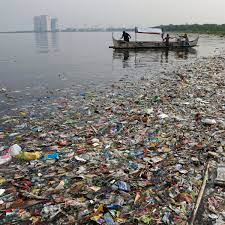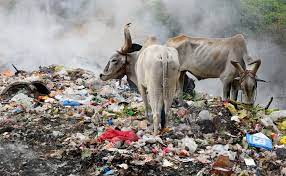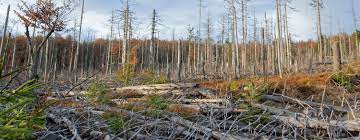Pollution: A Scourge on Our Planet
Pollution is the introduction of harmful materials into the environment, altering its natural state and causing adverse effects on living organisms and ecosystems. These harmful materials, called pollutants, can be in the form of solid, liquid, or gas. While some pollution occurs naturally, such as volcanic eruptions or dust storms, the most pressing concern today is human-caused pollution.

Types of Pollution:
Air Pollution:
Caused by emissions from vehicles, factories, burning fossil fuels, and even agriculture.
Leads to respiratory problems, acid rain, and climate change.
Image of Air pollution from factoriesOpens in a new window
www.ecotextile.com
Air pollution from factories
Water Pollution:
Contaminated water from industrial waste, agricultural runoff, sewage, and chemicals.
Harms aquatic life, spreads diseases, and limits access to clean drinking water.
Image of Water pollution from factoriesOpens in a new window
www.h2o-de.com
Water pollution from factories
Land Pollution:
Caused by landfills, improper waste disposal, deforestation, and the use of pesticides and fertilizers.
Contaminates soil, reduces fertility, and disrupts ecosystems.
Image of Land pollution from factoriesOpens in a new window
medium.com
Land pollution from factories

Noise Pollution:
Excessive noise from traffic, construction, and machinery.
Can cause hearing loss, stress, and sleep disturbances.
Image of Noise pollution from trafficOpens in a new window
www.forbesindia.com
Noise pollution from traffic
The Impact of Pollution:
Human Health: Pollution is a major threat to human health, causing respiratory illnesses, heart disease, cancer, and even birth defects.
Biodiversity Loss: Pollution harms ecosystems and contributes to the decline of plant and animal species.
Climate Change: Air pollution, particularly greenhouse gases, traps heat in the atmosphere, leading to climate change and its associated impacts, such as extreme weather events and rising sea levels.
Economic Costs: Pollution cleanup and the health impacts of pollution cost billions of dollars each year.
Combating Pollution:
Reduce emissions: Transitioning to cleaner energy sources, using public transportation, and practicing energy efficiency are crucial steps.
Waste management: Proper waste disposal, recycling, and composting can significantly reduce land pollution.
Sustainable agriculture: Reducing the use of pesticides and fertilizers can minimize water pollution and improve soil health.
Pollution control technologies: Implementing pollution control measures in industries and factories can help mitigate their environmental impact.
Individual actions: Every individual can contribute by reducing their carbon footprint, making sustainable choices, and advocating for environmental protection policies.
Conclusion:
Pollution is a complex and global challenge, but it is not insurmountable. By working together, adopting sustainable practices, and implementing effective policies, we can create a cleaner and healthier planet for ourselves and future generations.
Additional Resources:
World Health Organization: https://www.who.int/health-topics/air-pollution
United Nations Environment Programme: https://www.unep.org/
Environmental Protection Agency: https://www.epa.gov/
I hope this information provides a comprehensive overview of pollution and its impacts. Please let me know if you have any further questions or would like to delve deeper into specific aspects of this topic.
Delving Deeper into the Scourge of Pollution:
Air Pollution:
Invisible Menace: Air pollution often takes the form of invisible gases like carbon dioxide and nitrogen oxides, making it a silent threat. However, its effects are far-reaching, causing respiratory problems like asthma and bronchitis, and even contributing to heart disease and cancer.
Image of person wearing a mask in a polluted cityOpens in a new window
www.freepik.com
person wearing a mask in a polluted city
Global Traveler: Air pollution doesn't respect borders. Wind currents can carry pollutants across vast distances, impacting air quality in regions far from the source.
Acid Rain: When sulfur dioxide and nitrogen oxides from fossil fuel burning mix with water vapor in the atmosphere, they form sulfuric and nitric acids. These acids fall as acid rain, damaging forests, lakes, and aquatic life.
Image of forest affected by acid rainOpens in a new window
ypte.org.uk
forest affected by acid rain

Water Pollution:
Plastic Peril: Plastic pollution is a major threat to our oceans and waterways. Millions of tons of plastic enter the oceans each year, harming marine life and entering the food chain.
Image of sea turtle entangled in plasticOpens in a new window
www.vecteezy.com
sea turtle entangled in plastic
Dead Zones: When excess nutrients from fertilizers and sewage runoff enter waterways, they can trigger algal blooms. These blooms deplete the water of oxygen, creating "dead zones" where aquatic life cannot survive.
Image of dead zone in the oceanOpens in a new window
en.wikipedia.org
dead zone in the ocean
Microplastic Menace: Microplastics, tiny plastic fragments less than 5 millimeters in size, are now found everywhere from the deepest ocean trenches to the Arctic ice. These microplastics can be ingested by marine life, posing a threat to their health and potentially ours.
Image of fish with microplastics in its gutOpens in a new window
www.sciencelearn.org.nz
fish with microplastics in its gut
Land Pollution:
Toxic Legacy: Improper waste disposal, particularly of hazardous materials, can contaminate soil and groundwater for generations. Landfills can leak harmful chemicals, while industrial waste can poison the land, making it unusable for agriculture or other purposes.
Image of polluted landfillOpens in a new window
www.craiyon.com
polluted landfill
Deforestation: Clearing forests for agriculture, logging, and development destroys habitats, disrupts ecosystems, and contributes to climate change.
Image of deforestationOpens in a new window
www.nationalgeographic.org
deforestation
Soil Erosion: Unsustainable agricultural practices and deforestation leave soil vulnerable to erosion by wind and water. This loss of topsoil reduces land fertility and can lead to desertification.
Image of soil erosionOpens in a new window
www.worldwildlife.org
soil erosion
Combating Pollution: A Collective Effort:
Renewable Energy: Transitioning from fossil fuels to renewable energy sources like solar, wind, and geothermal power is crucial for reducing air pollution and mitigating climate change.
Image of solar panel arrayOpens in a new window
www.solarreviews.com
solar panel array
Sustainable Transportation: Walking, cycling, using public transportation, and choosing electric vehicles can significantly reduce air pollution from transportation.
Reduce, Reuse, Recycle: Reducing our consumption, reusing materials, and recycling waste can minimize the amount of pollution generated in the first place.
Individual Choices:
Every action counts. Making sustainable choices in our daily lives, from using energy-efficient appliances to buying locally-sourced products, can contribute to a cleaner planet.
By understanding the different types of pollution, their impacts, and the ongoing efforts to combat them, we can all play a role in creating a healthier and more sustainable future for ourselves and future generations.
I hope this expanded information, along with the visuals, provides a deeper understanding of the multifaceted issue of pollution. Remember, even small changes in our daily lives can make a significant difference in the fight against this global challenge.


You must be logged in to post a comment.